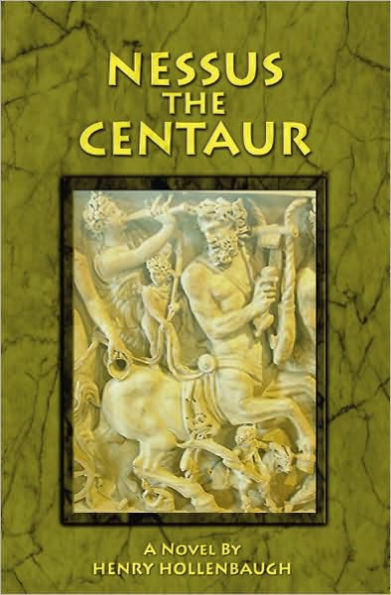The ancient myth of Hercules, Dejanira and Nessus the Centaur is retold in this novel as a love triangle of sorts, by the author’s engaging character, Jonathan Nestus, a reincarnation of the Centaur, reliving periodic episodes in the life and times of Nessus, horse’s parts and all. In this modern retelling of the myth, Nessus is the tragic hero and Hercules is the despicable, murderous villain. In the main body of the novel, populated by centaurs, satyrs and mermaids, the author weaves a fantastic but plausible plot. What actually transpired at the River Avenus? How and why did Hercules poison his arrows? Does that poison still exist today? How could Dejanira have been so foolish as to believe what the dying Nessus told her about the magical properties of his blood? And what was it that drove Nessus to perpetrate his almost insane act of trying to violate the wife of Hercules, the most feared and deadly man of those times, before his very eyes?
As he retells the main story, Jonathan Nestus intersperses the chapters of another book, A Short History of the Centaurs, which he is writing to impress his modern-day lady friend Daphne. In the Short History of the Centaurs, replete with literary and classical allusions and the retelling of many of the Greek myths from a modern perspective, the author’s character provides explanations for the abundance of weird creatures in ancient times, rendered almost believable by his pseudo-scientific reasoning: It was all due to interspecies breeding, he tells us, which was made possible because of certain atmospheric conditions that prevailed in those times.
Whether the reader is familiar with Greek mythology or not, this tragic-comic love story is an enthralling read.
1100542022
As he retells the main story, Jonathan Nestus intersperses the chapters of another book, A Short History of the Centaurs, which he is writing to impress his modern-day lady friend Daphne. In the Short History of the Centaurs, replete with literary and classical allusions and the retelling of many of the Greek myths from a modern perspective, the author’s character provides explanations for the abundance of weird creatures in ancient times, rendered almost believable by his pseudo-scientific reasoning: It was all due to interspecies breeding, he tells us, which was made possible because of certain atmospheric conditions that prevailed in those times.
Whether the reader is familiar with Greek mythology or not, this tragic-comic love story is an enthralling read.
Nessus The Centaur
The ancient myth of Hercules, Dejanira and Nessus the Centaur is retold in this novel as a love triangle of sorts, by the author’s engaging character, Jonathan Nestus, a reincarnation of the Centaur, reliving periodic episodes in the life and times of Nessus, horse’s parts and all. In this modern retelling of the myth, Nessus is the tragic hero and Hercules is the despicable, murderous villain. In the main body of the novel, populated by centaurs, satyrs and mermaids, the author weaves a fantastic but plausible plot. What actually transpired at the River Avenus? How and why did Hercules poison his arrows? Does that poison still exist today? How could Dejanira have been so foolish as to believe what the dying Nessus told her about the magical properties of his blood? And what was it that drove Nessus to perpetrate his almost insane act of trying to violate the wife of Hercules, the most feared and deadly man of those times, before his very eyes?
As he retells the main story, Jonathan Nestus intersperses the chapters of another book, A Short History of the Centaurs, which he is writing to impress his modern-day lady friend Daphne. In the Short History of the Centaurs, replete with literary and classical allusions and the retelling of many of the Greek myths from a modern perspective, the author’s character provides explanations for the abundance of weird creatures in ancient times, rendered almost believable by his pseudo-scientific reasoning: It was all due to interspecies breeding, he tells us, which was made possible because of certain atmospheric conditions that prevailed in those times.
Whether the reader is familiar with Greek mythology or not, this tragic-comic love story is an enthralling read.
As he retells the main story, Jonathan Nestus intersperses the chapters of another book, A Short History of the Centaurs, which he is writing to impress his modern-day lady friend Daphne. In the Short History of the Centaurs, replete with literary and classical allusions and the retelling of many of the Greek myths from a modern perspective, the author’s character provides explanations for the abundance of weird creatures in ancient times, rendered almost believable by his pseudo-scientific reasoning: It was all due to interspecies breeding, he tells us, which was made possible because of certain atmospheric conditions that prevailed in those times.
Whether the reader is familiar with Greek mythology or not, this tragic-comic love story is an enthralling read.
5.0
In Stock
5
1

Nessus The Centaur

Nessus The Centaur
Related collections and offers
5.0
In Stock

Product Details
| BN ID: | 2940011892189 |
|---|---|
| Publisher: | Alondra Press, LLC |
| Publication date: | 01/02/2009 |
| Sold by: | Barnes & Noble |
| Format: | eBook |
| File size: | 243 KB |
About the Author
From the B&N Reads Blog
